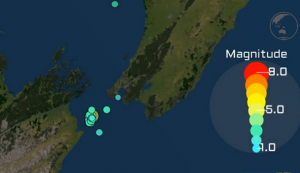UPDATED: Wellington is largely open for business again following Sunday’s magnitude 6.5 earthquake. Scientists yesterday re-evaluated probabilities for aftershocks suggesting a 19 per cent probability of a M6+ aftershock in the next week – down form 30 per cent.
AUDIO: GNS Science’s Dr Ken Gledhill updates earthquake probabilities
Latest update from Geonet: What fault are the Cook Strait earthquakes on?
Stuff live chat with GNS seismologist Stephen Bannister (Monday)
Herald Online live chat with GNS seismologist John Ristau (Monday)
GNS Science backgrounder on Wellington’s faults.
Historical context
Euan Smith, Professor of Geophysics, Intsitute of Geophysics, School of Geography, Environment and Earth sciences, Victoria University of Wellington comments on the series of earthquakes and aftershocks centred near Seddon.
Wellington’s latest earthquakes – it has happened before.

“Few events in the natural world are unprecedented. While Wellingtonians reflect on the latest reminders that we all live in a dynamic place, they may be interested to know that something very similar happened in January 1950.
“Then, between January 6 and about January 28 more than 30 earthquakes above magnitude 3 occurred in Cook Strait, about 50 km north and slightly further west than the current quakes. This swarm featured four earthquakes above magnitude 5, between January 7 and 21. We have so far had two of magnitude greater than 5, on Friday and this morning (Sunday, 21 July2013), accompanied by numerous smaller ones.
“These two larger earthquakes are scientifically interesting because of their faulting type. Fault types can be inferred from the way in which earthquakes radiate waves all around the world. The USGS Earthquake Information Centre uses these waves to estimate the location, depth and faulting type.
“Their models show that our two bigger ones resulted from the squeezing of Wellington in the boundary between the Pacific and Australian tectonic plates.Their depths are consistent with them occurring on the boundary surface between the Pacific plate, which is sinking northwestwards under the North Island and northern South Island, and the overlying Australian plate.”
What can we learn from this near repeat of history?
“As some scientists have already indicated, earthquakes are likely to continue near Wellington for some time – no-one can say how long. Some of them could be as large, or larger, than the ones we have just had. Therefore, anyone with property or possessions which are vulnerable to being knocked over or down and damaged should take steps to secure them. In our land of recurrent earthquakes this is always good advice.”
News round-up: A selection of science-related stories on the quakes
Wednesday
Stuff: Fault larger than thought
3News: NIWA to check damage to sea floor
Tuesday
The Press: Time to prepare for Alpine Fault quake
Dominion Post: Swarm could trigger capital fault
Stuff: GNS Science revises aftershock probabilities
The Press: Quakes centred near large South Island faults
Scoop: Extra instruments deployed to capture aftershock data
Monday
3 News: One in three chance of another biggie
NBR: Wellington quakes likely to continue – some could be larger
The Marlborough Express: Quake part of evolving sequence
The Marlborough Express: Earthquake – GNS explains
Fairfax: Bigger than Feb 22 quake